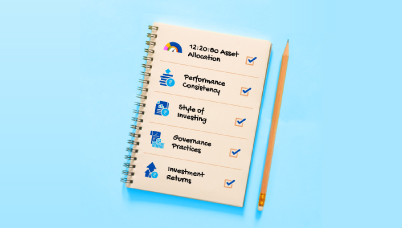Can Mutual Fund Investment Choices Be Too Overwhelming?
Posted On Friday, Mar 11, 2016
“I spent the last 4 hours in that one store” referring tiredly to the sprawling clothes-to-crockery retail store on the floor below.
“Oh, okay… I hope you got the stuff you wanted”… trying not to express amazement at how she could shop so long at a single store. I knew it’s one of her favourites, and they were running a once-in-6-months 60% discount sale!
“Well, that’s the sad part. I wanted to get a ladies bag. And after spending 4 hours shopping it’s so disappointing to not buy.”
“Oh dear. Didn’t they have anything interesting?”
“That’s the problem! They simply had too many interesting bags – a fresh collection of hand bags, sling bags, totes and clutches. I found a tote just perfect for me but then there was a turquoise, leather sling bag, which is a colour I always wanted. They had about 6 shades in each bag design. I even liked a few hand bags… but somehow I ended up not buying anything… coz I don’t want to regret later for not buying a different, better one from among them.”
“I understand… that’s sad. So you plan to check out a different store?”
“Not today; I’m out of all energy. Let’s see if I can get my hubby accompany me tomorrow.”
And thus the friend went home without buying a bag. Isn’t it ironic, that the sheer choice of bags which was supposed to enhance her buying experience, posed as a deterrent to buying?
The paradox of choice
Perhaps many of us can relate to this friend’s experience. Times today are different from what they used to be. Every time there is a choice to be made – be it buying clothes, gadgets, or other things online, even possibly at a physical store, the variety made available at the product design and feature level is dizzying. Indeed extensive choice has always seemed appealing and that is the reason behind marketing practices of departmental stores offering aisles of potato chips and wafers, toothpaste in a dozen flavours and 25 styles of jeans.
Nevertheless in certain situations, especially where some amount of product knowledge is required to make a confident buying decision, we can be subjected to “choice overload” resulting in the likelihood that we’d end upchoosing not to choose, just like the friend described above.
This fact is put forth by psychologist Barry Schwartz in his book The Paradox of Choice – Why More is Less, published in 2004. Here he argues that against traditional assumption, eliminating choices can greatly reduce anxiety for consumers. And four years prior to this, psychologists Sheena Iyengar and Mark Lepper had carried out the remarkable study of the effect of choice on decision making using jams. The results completely challenged the age old notion of consumer choice and buying.
The Jam experiment and America’s 401(k)
On one day, shoppers at an upscale food market saw a display table with 24 varieties of gourmet jam. Those who sampled the spreads got a coupon for $1 off on any jam. On another day only six varieties of the jam were on display. The large display attracted more interest than the small one. But when the time came to purchase, people who saw the large display were ten times less likely to buy as people who saw the small display. More choice translated to less buying.
Interestingly Iyengar and another team extended the study to investments and proved the same to be true here too. They tested the hypothesis that when employers offered a large choice of funds in the 401(k) plans fewer employees were likely to participate. 401(k) is the American equivalent of Provident Fund in India, except that in the former employees can choose which funds to contribute to. The results showed that there were significant drops on comparing participation rates in the retirement plans offering a just a few funds as compared to plans offering ten or more options.
The takeaway from these studies and analyses is that presenting too much differentiation in investment products could result in investors being intimidated instead of being induced to buy any of those investment products.
Too much of a good thing – Indian mutual fund categories
The problem of too much exists in the Indian mutual funds scenario too. We believe the industry has compartmentalized mutual funds into far too many categories than are helpful for investors.
However in the marketing materials of AMCs or fund rating websites an investor is likely to encounter a plethora of fund classes – ranging from 5 to 15 or more. Sample the typical classification based on asset class:

The problem is not only limited to numerous categories but also to the number of schemes offered by fund houses in each of these categories. For instance, for the simple need of Tax Saving an investor’s choice is made complex if he has to pick from 3 different Tax Saving funds being offered by a single fund house.
One might deduce that fund houses launch multiple schemes within a single category for the same marketing reason as the department stores do. The belief that the more choice they throw out the better off they would be at attracting investors.
Making your investment choice process more effective
For their part, what investors can do to make their life simpler is to have an effective choice process. There are no two ways about where to begin the investment product choice: it must start with identifying your goal. Next select the asset class whose characteritics is aligned to help fulfill your goal. At this point you will know that it is an equity, debt, gold, liquid or multi asset fund that you want to invest in. Further finetuning may not be neccesary a this stage(you can choose without the large cap, mid cap, small cap, multi cap game) and you are ready to choose the specific scheme.
Now comes the tough part. Suppose you need to pick up an equity scheme and you visit a website rating funds for neutral reviews. Here you will be faced with the Everest climbing task of selecting from among 200+ schemes! Naturally, investors may be inclined to filter funds based on past performance for 5, 10 years etc and choose from the top rated ones. Or they might rely on the inclusion of funds in a so-called “Ivy League” prepared by a third party, based on criteria that actually may or may not have an effect on long term performances. Does this method of choosing funds guarantee investor satisfaction in the long run? Experiences of investors suggest otherwise.
So we believe in a different way of choosing funds. This method is based on one’s comfortability with the fund house offering investment products. Do you believe in the philosophy of investments adopted by the fund house (assuming there is one and it is publicly available)? Are you convinced of the processes, risk management measures, profit-approach of the AMC? Does the fund house invest in and offer good investor service? Trust us, although this point may not feature at the top on many investors’ mind it is worth considering because this is a relationship to be maintained for decades possibly.
And when chosen in this way the investor will hopefully remain confident, even when his boat encounters rough weather in the sea. He can rest assured that the honest, experienced crew can be trusted to do what’s best for him always and reach him at the destination of his goals.
Of course, now to be able to choose in this manner investors have to be more involved in the decision making process. It requires more time and effort than mere selecting based on stars or ranking. But the end result will no doubt be more satisfying and fruitful.
This is what we aim to do for our investors, both current and potential, through our newsletters and articles – educate them to make the right investment choices. After all, you would not want to lose the opportunity of seeing your dreams come true by choosing not to choose. And with your hard earned money, you want to be sure that it is in good hands. Do consult your financial advisor for more on your personal invesmtent decisions.
Source: Jam experiment, 401k retirement plans
The views expressed here in this article are for general information and reading purpose only and do not constitute any guidelines and recommendations on any course of action to be followed by the reader. The views are not meant to serve as a professional guide / investment advice / intended to be an offer or solicitation for the purchase or sale of any financial product or instrument or mutual fund units for the reader. The article has been prepared on the basis of publicly available information, internally developed data and other sources believed to be reliable. Whilst no action has been solicited based upon the information provided herein, due care has been taken to ensure that the facts are accurate and views given are fair and reasonable as on date. Readers of this article should rely on information/data arising out of their own investigations and advised to seek independent professional advice and arrive at an informed decision before making any investments.
Mutual fund investments are subject to market risks read all scheme related documents carefully.
Related Posts
-

Do You Need to Update Your KYC/Modify KYC?
Posted On Friday, Apr 26, 2024
New KYC Regulation Effective April 1st 2024
Read More -

Are You Stuck in the Past or Ready for a Secure Future?
Posted On Wednesday, Jun 29, 2022
The ever-growing number of mutual fund schemes on offer has made it challenging for investors to select the best and most suitable one.
Read More -

Received an Increment? Step-up Your SIPs
Posted On Wednesday, Jun 01, 2022
For instance, let’s assume that you have registered for a monthly SIP of Rs 5,000 for a 10-year period and later on try to step-up the SIP at an annual frequency, say by Rs 500. In the first year...
Read More



